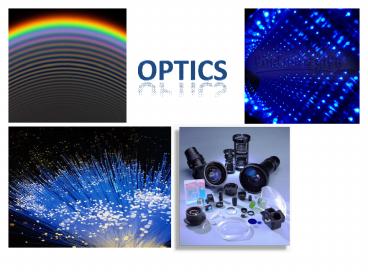Optics - PowerPoint PPT Presentation
Title: Optics
1
Optics
2
The Deviation of Light Waves
- Light propagates rectilinearly (in a straight
line) - when the substance it travels through allows
it - Some objects are visible because they emit their
own light, they are luminous. - Others are visible only because some light rays
bounce off their surface towards our eyes - This phenomenon is called reflection.
3
Reflection
- What allows us to see two balloons?
4
Reflection
- Some light rays are emitted in all directions
And allow us to see the object directly
Surface or the water
Other light rays bounce back the surface of the
water, allowing us to see an inverted copy of the
object
Thus the illusion of another object in the water
the VIRTUAL IMAGE
5
Reflection
6
Reflection
?i
?r
Angle of incidence
Angle of reflection
7
Optic Fibers
- Optic fibers are designed to reflect light
throughout their entire length, thus emitting an
ultrafast, low-temperature and very accurate
signal
8
The Deviation of Light Waves
- Sometimes, when light travels from one substance
to another with a different density, part of the
light rays are deviated without being reflected - This phenomenon is called refraction.
9
- For example, if a light ray travels from air to
water (liquid), it penetrates another substance
with a different density - Examples of light refracting materials are water,
glass, plastic, diamonds and oils
10
REFRACTION
- Normal
Normal
?i
?r1
Incident Ray
Reflected Ray
Glass
The refracted ray is deviated toward the normal,
since the light ray travels from less dense to
denser matter
Refracted Ray
?r2
Angle of Refraction
11
REFRACTION
Normal
Normal
This time, the refracted ray is deviated away
from the normal, since the light ray travels from
denser to less dense matter
?r2
Angle of Refraction
Refracted Ray
Glass
Incident Ray
Reflected Ray
?i
?r1
12
REFRACTION
Real fish, actual position
Virtual fish, illusory position
13
Uh?
- Archer fish are better than the best baseball
players at predicting where plummeting prey will
land, suggests a new study. They need only one
glance although their eyes see their prey at a
refracted angle. - The fish (Toxotes jaculatrix) shoot water jets
from their mouths at insects perched overhead. - After a hit, they have to guess where their lunch
will land, and get to it before it's gobbled by
fellow fish.
14
Lenses
- There a 2 type of lenses
- Convergent lenses
- Divergent lenses
15
Convergent Lenses
- Biconvex lens
Planoconvex lens
Convergent meniscus
16
Convergent Lenses
Incoming light rays
Focal Point
Optical axis of the lens
Refracted light rays
17
Convergent Lenses
- The light rays converge to a specific point on
the axis of the lens. - This point is called the focal point, and its
location on the axis is determined by the
curvature of the lens. - The more pronounced the curve of the convergent
lens, the closer to the lens the focal point is.
18
Convergent Lenses
- Example of a more pronounced curve
Focal Point
Optical axis of the lens
Refracted light rays
Incoming light rays
19
Convergent Lenses
- This is not exactly true though
- In reality Biconvex lens create a double
refraction of the light rays, like so
Focal Point
Incoming light rays
Refracted light rays
Optical axis of the lens
20
Divergent Lenses
Biconcave lens
Planoconcave lens
Convexo-concave lens
21
Divergent Lenses
Incoming light rays
Optical axis of the lens
Refracted light rays
Focal Point
22
Divergent Lenses
- This time, the light rays are deviated away from
the axis. - The focal point is found by extending the
refracted rays until they meet - This point of origin of the refracted rays is the
Focal Point - The focal point is now on the same side as the
incoming rays of light
23
How it works
24
How it works
25
So overall
26
End































